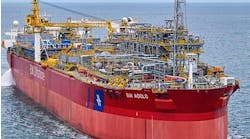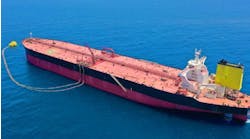John Waggoner, Technology Editor, Drilling & Production
Deep and high pressure stim jobs remain the drivers for new stim vessel technology this year. Industry sources report that the market in 2009 has adjusted from the boom during the previous year, coinciding with a decline in oil prices that have hit the service market in general. The leaner market has coincided with increased innovation for well stimulation services, with new technologies aimed at specialized downhole conditions in areas of long term growth.
The key markets for new vessels in 2009 are West Africa and the Gulf of Mexico, according to responses from industry sources. Some interesting updates around the world can be reviewed in this year’s World Survey of Stimulation Vessels.
The rollouts of new technology this year sport state-of-the-art upgrades geared toward the challenges operators face in high pressure/high temperature (HP/HT) environments. New vessels such as Halliburton’sStim Star Angola and BJ Services’ Blue Dolphin are specially tailored for sophisticated frac jobs and large scale, with an eye toward saving non-productive time (NPT).
The fluids and additives market continues to respond to the needs of operators with well stimulation technologies designed for HP/HT applications along with other subtle innovations in materials to define state of the art in offshore stim technology in 2009.
Stim Star Angola has custom features for West Africa
At the Bollinger shipyard in Amelia, Louisiana, Halliburton engineers and technologists are working with shipbuilders to outfit a new 240-ft (73-m) stimulation vessel, theStim Star Angola. The vessel will be available by the third quarter of this year and will be based in Soya, Angola.
The vessel is designed for advanced well stimulation applications in West Africa, a region which is expected to see continued development over the next several years. Angola is particularly important to the region, with nine major projects expected to start up through 2011, according to the US Energy Information Administration (EIA).
West African offshore well completions are characterized by the extreme depth and temperature of the reservoirs, as well as complex geology that requires advanced sand control and well stimulation technologies to achieve success. These conditions typically range from deviated cased-hole wellbores to open-hole horizontal laterals requiring fracpacks, proppant fracturing, acid fracturing, matrix acidizing, and cased- and open-hole gravel packs. To add to the challenge, multizone horizontal stimulation, formation stabilization, and scale control are also common challenges that operators face in the region.
TheStim Star Angola is being built with these conditions in mind. The high performance vessel is designed to help reduce rig NPT and lower associated costs for area operators.
A key feature of the vessel will be its certification for DP-2 dynamic positioning. This technology allows operations in difficult sea conditions at TLPs, drillships, large semisubmersibles, or single wellheads by using computers to automatically maintain a vessel’s position and heading by using onboard propulsion systems. Position reference, motion, and wind sensors combined with gyro compasses provide input about vessel position and environmental forces affecting the vessel. The computer eliminates the need for mooring to platforms and drillships.
Another important innovation of the vessel is the ability to deliver Halliburton’s advanced SurgiFrac technology that is designed for precise control of fracture placement in deviated and horizontal wellbores with no mechanical isolation devices. This ability helps optimize reservoir drainage even in existing assets while reducing fracturing time and costs. Recently a major operator used the procedure to reduce completion time by 50% offshore West Africa.
Stim Star Angola will be outfitted with a unique acid blending and pumping system tailored for the intense acid-stimulation often required for extended-reach horizontal wells in the region. Because of contrasting permeability between layers of rock common in West Africa, often found at the heel of the horizontal wellbore, emulsified acid stimulation can be needed. Emulsified acid provides several advantages including more complete coverage since emulsified acid can reach the farthest portions of the wellbore before it is completely spent. The vessel will be equipped to deliver both emulsified and conventional acid systems.
The fracturing fluid system for the vessel is also state of the art, with seawater-compatible mixing and a gel-on-the-fly system that uses a fully hydrated gel concentrate to save time and limit environmental exposure since the excess gel remains on board.
Additional innovations to reduce NPT include a plant to convert sea water into drinking water and an onboard crane to supply the vessel without waiting for a dockside crane to become available. The vessel’s storage capacity allows multiple stimulation operations in many cases without a return to base.
Blue Dolphin set to deploy to ultra deepwater in GoM
BJ Services’Blue Dolphin ultra deepwater stimulation vessel is a class-certified, dynamically positioned (DP-2) vessel equipped with 20,000-psi (137.9-MPa) pumps and service iron. The vessel is currently under construction in Louisiana and set to deploy to the Gulf of Mexico in the fourth quarter of this year once completed.
TheBlue Dolphin will carry three Coflexip reeled flexible steel umbilical lines that allow up to 80 bbl/min (12.7 m³/min) pumping rates. The lines are supported by 23,000 available hydraulic horsepower (HHP).
The vessel features accommodations for 45 crew members, allowing nonstop operations for large-scale projects. Applications include:
- Ultra deepwater stimulation operations, including fracturing and acidizing
- Sand control operations.
The new vessel sports state of the art equipment such as:
- Gas detection system
- Full-flow pressure relief valve actuated from control room
- Redundant electronic overpressure shutdown systems
- High-level alarms on all service tanks and liquid additive tanks
- Fire-detection panel in control room and on bridge level
- Treatment level sensors with indication alarms monitor conditions of all stimulation processing tanks
- Remote critical valve processing actuation is available via the control room command center
- Fully automated ratio controls for the addition of proppant and additives
- State-of-the-art touch-screen control room electronics with wireless transmission of wellhead parameters
- Remote satellite transmission of data and video with dual satellite backup systems
- Selectable remote data display
- Wi-Fi in control room and customer quarters
- Two Caterpillar C-280-8 diesel engines drive controllable pitch propellers (CPP)






